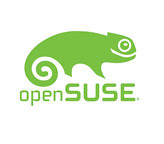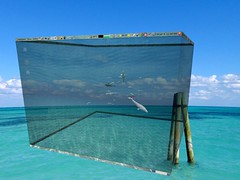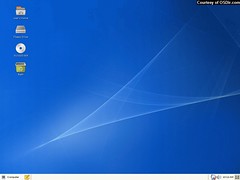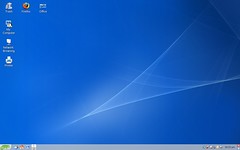Away for a Bit
Thursday, July 19, 2007
Hello all!
I am leaving for Germany today on vacation, and will not return until August 15th. Much to my dismay, I will have very limited internet access on this trip, and will therefore not be able to post much, if anything at all.
So, until then, enjoy your summer, and I'll continue posting when I return!
Farewell!
-linnerd40
I am leaving for Germany today on vacation, and will not return until August 15th. Much to my dismay, I will have very limited internet access on this trip, and will therefore not be able to post much, if anything at all.
So, until then, enjoy your summer, and I'll continue posting when I return!
Farewell!
-linnerd40
Officially past 100,000 visitors :-)
Saturday, July 07, 2007
Hello all.
Just recently, Just Another Tech Blog received its official 100,000th page view (check the stats here)! Needless to say, I am very excited!
I'd just like to thank all my returning visitors who have been with me since the beginning! And pretty much all my visitors! I strive to make excellent content available on this blog, and enjoy every minute I spend blogging!
-linnerd40
Blog Author (ha, ha! Who else?)
Just recently, Just Another Tech Blog received its official 100,000th page view (check the stats here)! Needless to say, I am very excited!
I'd just like to thank all my returning visitors who have been with me since the beginning! And pretty much all my visitors! I strive to make excellent content available on this blog, and enjoy every minute I spend blogging!
-linnerd40
Blog Author (ha, ha! Who else?)
Awesome CompizFusion Plugin: Cube Atlantis
Friday, July 06, 2007
People are quickly discovering all the awesome plugins of the new CompizFusion. One of coolest plugins, in my opinion, is the new "Cube Atlantis". What the plugin does is basically render a few fish, sharks, whales, and dolphins in your desktop cube! It is quite fun to watch :D
Check out this vid:
Sorry about the horrible quality, xvidcap really lags things up a bit :) (the actual performance is excellent!) Here are a few screen shots that I took, on the right you can see the various settings available for customization under the compiz-config settings manager:
The settings available for customization include:
* For those finding the theme portrayed above appealing, the skydome wallpaper can be found here, and the desktop wallpaper here.
Check out this vid:
Sorry about the horrible quality, xvidcap really lags things up a bit :) (the actual performance is excellent!) Here are a few screen shots that I took, on the right you can see the various settings available for customization under the compiz-config settings manager:
The settings available for customization include:
- Number of fish (1-100)
- Different color fish (Yes or No)
- Fish Size (1-10000)
- Shark Size (1-10000)
- Dolphin Size (1-10000)
- Whale Size (1-10000)
* For those finding the theme portrayed above appealing, the skydome wallpaper can be found here, and the desktop wallpaper here.
A Review of openSUSE 10.2
Thursday, July 05, 2007
 Back in the day, when I first started using Linux, Novell's SUSE Linux was the first distribution that I came across that actually worked with my wireless card. Over the course of a year or so, I went through versions 9.3, 10.0, and 10.1. Needless to say, a lot has changed since SUSE 9.3 that makes the distribution ever more welcoming to new and advanced users alike. In this review, I'll take a look at the latest openSUSE release, 10.2, and see how it stacks up to its previous versions and other distros.
Back in the day, when I first started using Linux, Novell's SUSE Linux was the first distribution that I came across that actually worked with my wireless card. Over the course of a year or so, I went through versions 9.3, 10.0, and 10.1. Needless to say, a lot has changed since SUSE 9.3 that makes the distribution ever more welcoming to new and advanced users alike. In this review, I'll take a look at the latest openSUSE release, 10.2, and see how it stacks up to its previous versions and other distros.The Install:
Installing openSUSE 10.2 is not a very difficult thing to do. Download options consist mainly of 5 CDs (with an optional add-on CD) or 1 DVD in the common architectures (x86, x86_64, PPC, and IA64). Also available is a LiveDVD which lets you try openSUSE 10.2 before installing.
The installer is quite intuitive, and provides ample support along the way in the form of a sidebar displaying helpful information about the current step. For those liking to customize almost every detail of their installation, the SUSE installer is superb.
As with many installers, you are first asked about your default language. In the next step, you have the ability to check your installation media for errors which could compromise the installation (very useful). Then, after reading and agreeing to a license agreement, you can chose to upgrade an existing installation, or go for a completely new one. If you downloaded the Add-On CD, you will be able to add that to your repository for installation. Following this is a step in which you choose your desktop environment, both Gnome and KDE are available along with a few more obscure choices.
After this configuration is done, you are presented with an installation summary. READ THIS CAREFULLY! The default option for partitioning is to simply clear all partitions and create a new one for openSUSE. I question this choice, as it can easily be overlooked by a novice user. Losing all your data is perhaps not the first problem you want to deal with as a new Linux user.
The afore mentioned installation summary is also the place where you can change the packages to be installed. This is very useful, as it is often much easier to install packages right off the bat. The interface for choosing packages is what you will see when using YaST later on. Although not pretty, it does the job. With the add-on CD (included on the DVD), you can chose Non-OSS software such as the Java runtime environment and Adobe's Flash Player. The default package selection is excellent, and many users will find it perfectly adequate for normal, everyday use.
After setting everything up as you like it, the installer proceeds to install your new system. During the actual install, you can see the progress in a bar at the right which also lets you know how much time remains. You can also view individual package progress in the the second tab.
First Boot/ Configuration/ Appearance:
After installation was finished, there was still a bit more configuration do to. After restarting, I was greeted by a very nice looking GRUB splash screen with openSUSE 10.2's blue/ swirl color scheme. Also, the installer had detected my Windows install and my Ubuntu install. Sadly, this is where the fun ended.
Starting openSUSE 10.2 the normal method did not work, it simply hung forever on the startup screen. Luckily, there was a "failsafe" option already on the GRUB menu, which I chose. Although this got me to the configurator, I received an error message saying that the graphical interface was not configured properly due to the lack of a driver for my video card ("minimal install") or an improperly placed video card. This was a surprising error as my card (GeForce 6200) had always been detected in the past. I had to go through the configuration in a text like interface.
The configuration itself consisted of the usual setting of the root password, the creation of new users, and hardware configuration (more on this later).
After the configuration was complete, I booted into Gnome, as though the errors with my graphics card/ driver had never been. Surprisingly, my default screen resolution was detected (1680*1050) and was already set! This was very nice, as usually I had to install nVidia's driver first, manually (or in Ubuntu, through the "Restricted Drivers Manager").
The default openSUSE 10.2 Gnome desktop looked very professional, with a very appealing blue theme. I found this theme to be much more pleasing than Ubuntu's and even better than Fedora's. Another great feature was the new main menu. This menu incorporates your favorite applications, recent applications, a search feature, and links to system configuration/ management. Here's a quick pic of the default Gnome desktop (left, courtesy OSDir) and the KDE desktop (right):
After a bit of tweaking, I got my desktop looking like so:
 In the top left corner, you can see the new menu, which is a good step up from the standard "Applications, Places, and System" menus on most Gnome desktops. Overall, I love the look and feel of openSUSE 10.2, and think Ubuntu and other distributions can definitely learn from this professional attitude towards desktop themes (or just get rid of the "Human" theme!).
In the top left corner, you can see the new menu, which is a good step up from the standard "Applications, Places, and System" menus on most Gnome desktops. Overall, I love the look and feel of openSUSE 10.2, and think Ubuntu and other distributions can definitely learn from this professional attitude towards desktop themes (or just get rid of the "Human" theme!).Hardware Support:
This is where it gets interesting. As I mentioned before, upon initial reboot into configuration, openSUSE could not detect/ configure my video card. However, after initial configuration, I entered a desktop at my monitor's default screen resolution. I checked the xorg.conf file and found the driver to be set to "nvidia". This was a pleasant surprise as most distributions make one manually install the nVidia drivers. However, "glxinfo" reports "direct rendering: no". Apparently, this is so because these drivers are in fact not the proprietary nVidia drivers. The proprietary drivers can, however, be installed via YaST through the Add-On CD.
Another nice surprise was instant support for my wireless card. I was able to easily configure and enable my rt2500 based card, which was not the case in previous SUSE/ openSUSE versions. However, my surfing experience was painfully slow. My iGoogle homepage took more than 15 seconds to load! On my Ubuntu install, it loads almost instantly. My first thought was that it was a driver issue. So, I followed E@zyVG's excellent guide on his blog to install the rt2x00 drivers (beta). Although this helped performance a little bit, web pages still loaded really slowly. I Google'd the issue and found that it may be because of something to do with ipv6. So, I disabled ipv6 in my /etc/modprobe.conf file (add "alias net-pf-10 off") and in Firefox (about:config -> search ipv6 -> set "network.dns.disableIPv6" to "true"). I proceeded to tweak Firefox and install FasterFox. Webpages load a lot faster now, but performance is still fairly poor in comparison to Ubuntu or even Windows. I'm really not sure why this is so, and the problem is certainly annoying.
EDIT: I have been reading up on this problem, and it may have to do also with DNS lookups.
Other than these issues, openSUSE detected and configured all my hardware without problems.
Configuration Tools:
YaST (Yet Another Setup Tool) is openSUSE's system configuration center. Through YaST, you can do pretty much anything from installing software and adding repositories, to configuring network services and managing users. It is a very powerful tool, with but one major draw back... it's slow. It can also be fairly greedy with system resources such as RAM (don't try running SUSE on a system with less than 256MB of RAM).
However, for simple configuration, most options can be found through the new "Control Center." This control center, with built in search and filtering, makes customization and configuration a pleasant and easy experience.
The package manager found in YaST is nowhere near Synaptic, and I personally don't like the interface. Adding repositories also requires a good deal more work than in Ubuntu or Fedora. I would have liked to see yum installed by default, but I fear that it won't be in any openSUSE release anytime soon. Still, its is included on the DVD and can be installed through YaST (search "yum").
Media Support:
As with nearly all Linux distributions, media/ MP3 support does not come out-of-the-box. However, this can be enabled by adding the packman repository and installing the appropriate packages (a good guide can be found here). To get MP3 support through Amarok, you can follow the guide on the Amarok site.
Desktop Effects:
Many Linux distributions are now embracing desktop effects as a default feature that can be enabled after installation; openSUSE 10.2 is no different. If your hardware allows it, you can enable desktop effects by going to the new Control Center and from there choosing "Desktop Effects". The desktop effects that you get are courtesy Compiz. The dialog provides a few tab with options on customizing your effects.
Although this method is extremely simple to use, I prefer having more control over what effects I want and how they are to be used. In light of the new Compiz/ Beryl merger, I decided to go with the all new (and unstable) CompizFusion. Providing the best of both worlds (Beryl and Compiz), CompizFusion is the way to go! Installing CompizFusion is actually a very simple process, which is wonderfully explained and shown on the CyberOrg blog. In my experience, Compiz performs much better than Beryl, although it does lack some of Beryl's cutting-edge plugins and features.
Security:
openSUSE 10.2 is an incredibly secure Linux distribution. Yes, as is their nature, most Linux distributions are secure, but openSUSE takes it to a new level. The secret weapon? AppArmor. From the AppArmor information page: "AppArmor is designed to address the application security problem, which is to ensure that attackers cannot cause applications to do something undesirable." It does just that, providing excellent application level access controls, while being easier to maintain and configure than SELinux.
Thoughts:
Overall, I found using openSUSE 10.2 to be a very enjoyable experience. The one of the major downfalls that I came across was YaST. I am definitely not a fan of YaST. Ever since SUSE 9.3, I have been hoping and hoping for a better YaST, but I have yet to see even one major improvement. However powerful it may be, I just don't like its overall interface, and the package manager is dreadfully slow. I think the openSUSE team needs to spend just a bit more time to performance tune YaST and maybe touch up on the interface (especially the package manager). I can see how many people find YaST to be an excellent tool, and I encourage everybody to try it out for themselves.
My only other gripe about openSUSE 10.2 is the updater, which needs to be manually configured to see your third-party repositories. I really wish that it would automatically recognize the repositories that you configured through YaST. It is by far the worst updater I have come across, bested by both Fedora and Ubuntu.
On a much brighter note, I absolutely adore openSUSE 10.2's look and feel. The default Gnome desktop is so professional looking and aesthetic that it really doesn't need to be changed around much. Add to that the extraordinary new menu and control center, and you have a recipe for awesomeness.
In my experience, performance was excellent. Applications responded quickly and I felt that I never had to wait to long for something to open. Boot up was good, although it took just a tad longer than Ubuntu or Windows. Sadly, this excellence is greatly marred by YaST and the incredibly slow internet I experienced (no, I know it is not a connection issue, this same connection is perfect in Ubuntu and Windows).
I truly wish I could say that I wanted to switch to openSUSE, but it just won't happen. However great it feels, the internet issue and YaST will keep me from using this distro anytime soon. I can see that the openSUSE team has payed immense attention to detail, and I commend them greatly for that. They have created a distribution that is displays the best of what Linux has to offer.
To me, openSUSE is like that luxury car you want, but just can't have because it isn't economical.
Overall rating: 6/10
Controversy: What review of openSUSE would be complete without a comment on the controversy Novell has created in the Linux community? When Novell first made the deal with Microsoft, of course I was appalled, but I believe that people are taking out their anger on the wrong people! The developers of openSUSE strive to make a great Linux distro, and want to bring Linux to both the personal desktop and the workplace. I am sure that many of its developers were not in agreement with the Novell - Microsoft deal, and seeing people bash openSUSE makes me question what kind of community I am part of. Do I think that what Novell did to the Linux community is wrong? Of course! But will I take my anger out by not respecting a great Linux distribution? I don't think so. Let us see past the controversy, and embrace openSUSE for what it is, a first-rate Linux distribution made and supported by first-rate members of the open source community. One can only hope that Novell does not steer it in the wrong direction... that would be sad indeed.



















